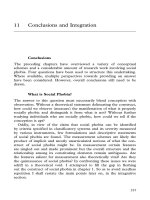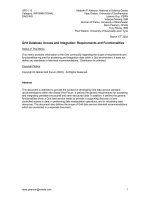Conclusions and Integration
Bạn đang xem bản rút gọn của tài liệu. Xem và tải ngay bản đầy đủ của tài liệu tại đây (148.05 KB, 22 trang )
11 Conclusions and Integration
Conclusions
The preceding chapters have overviewed a variety of conceptual
schemes and a considerable amount of research work involving social
phobia. Four questions have been used to structure this undertaking.
Where available, multiple perspectives towards providing an answer
have been considered. However, overall conclusions still need to be
drawn.
What is Social Phobia?
The answer to this question must necessarily blend conception with
observation. Without a theoretical statement delineating the construct,
how could we observe (measure) the manifestation of what is properly
socially phobic and distinguish it from what is not? Without further
studying individuals who are socially phobic, how could we tell if the
conception is apt?
Oddly, in view of the claim that social phobia can be identified
by criteria specified in classificatory systems and its severity measured
by various instruments, few formulations and descriptive statements
of social phobia are found. The measurement schemes are likely the
product of implicit and mostly unarticulated notions of what the con-
struct of social phobia might be. In measurement certain features
are singled out and made prominent but the overall structure and the
relationship among its constituting elements remain ambiguous. Are
the features salient for measurement also theoretically vital? Are they
the quintessence of social phobia? In confronting these issues we were
adrift in a theoretical void. I attempted to fill the gap in fleshing
out the construct of social phobia in chapter 1. So as to avoid needless
repetition I shall restate the main points later on, in the integrative
section.
337
What is the Nature of Social Phobia?
What good is it to ponder what social phobia is an instance of ? The
answer to this question is of some moment, for it determines the proper
terminology to be used as well as setting in train wider consequences for
research and treatment (e.g. what ought to be investigated, what consti-
tutes a proper treatment, what should be considered an improvement)
implied by the membership in a particular category.
Three classes have been considered: social phobia as an anxiety
disorder, as a disease and as an entity.
The formulation of social phobia as a disorder of anxiety is widely
accepted; its popularity is on the whole unjustified. Conceptually,
the scientific use of the term social anxiety so as to illuminate social
phobia stumbles on the fact that anxiety itself is such a muddled
notion (although the word is straightforward as the rough synonym of
fear).
The ambiguity of its status is well illustrated by the availability of
multiple competing definitions on the one hand and numerous mea-
surement inventories devised without reference to a specific construct
of anxiety on the other hand. Furthermore, most studies surveyed had
actually relied on a lay construct of anxiety since the participants in
those studies have defined it subjectively and idiosyncratically.
In absolute terms no specific sort of social phobic (or abnormal social)
anxiety has been identified. As to the somatic aspect, palpitations, trem-
bling, and sweating, for example, are self-reported not only by social
phobic subjects but also by various other individuals (e.g. with other
anxiety disorders) À notably the normal. In interpersonal terms, social
phobic patterns of behavior (e.g. keeping quiet, smiling ingratiatingly,
blushing) are rendered meaningful by the context in which they occur
and their manifest interpersonal function; the term anxiety offers no
added explanatory value.
Relatively speaking, no specific demarcation point cuts abnormal
social anxiety off from the normal sort. Thus, although social phobic
individuals typically rate themselves subjectively as more anxious than
do normal individuals, the difference between the two is one of degree
rather than in kind. If intermediate degrees of severity are admitted (e.g.
of the shy or individuals with other clinical problems) these become
consistent with a continuum of social fears, with social phobic individ-
uals, as a group, at its high end. Furthermore, when physiological indi-
ces of fear are objectively measured in the laboratory, the differences À
often significant on the continuum of subjective anxiety À blur or
vanish altogether. Thus, the social phobic fear reaction is very much
338 Concluding Remarks
an exacerbation of normal fear. It is exaggerated in intensity, over-
generalized in scope and prolonged in duration.
As children mature towards adolescence and then young adulthood,
social fears become prominent while fears of harm and punishment
wane. Social fears, unlike social phobia, remain commonplace.
Naturally, so are the situations evoking these. Speaking in public, deal-
ing with people in authority, competing in full view of others, evoke
anxious discomfort in most people. In the final analysis, although at
times extreme, so far as anxiety is concerned social phobic individuals
display normal tendencies.
Why is then the construct of social anxiety so widely used despite
its evident flaws and rather tenuous empirical support? Likely, the out-
look in which the term anxiety serves as a cornerstone is not formed
in response to solid theorizing and supporting evidence alone.
Underpinning it is a widely held but unspoken assumption that
(social) anxiety is the expression of a dysfunction of certain (as yet
unknown) regulatory mechanisms within the individual; social phobia
would be its ultimate consequence. In short, social phobia might be a
disease of sorts.
If rhetoric were the deciding factor, there would be little doubt that
social phobia is a disease. It is named as such in many publications
(with the term disorder as a blander synonym). Social phobia is found
in diagnostic manuals and studies of epidemiology. That much is also
suggested by the vocabulary in use: individuals seeking help are
‘‘diagnosed with’’ or are ‘‘suffering from’’ social phobia. Apprehensions
about and a strong preference toward avoidance of some social occa-
sions are said to be its ‘‘symptoms’’ and so is the dread of humiliation.
According to the DSM-IV, ‘‘individuals with social phobia almost
always experience symptoms of anxiety e.g. palpitations, tremors, sweat-
ing, blushing.’’ A closer inspection of both conception and the support-
ing evidence suggests that the medical vocabulary does not snugly fit
reality.
Conceptually, disease is viewed in medicine materialistically; in terms
of (observable) lesions to cells, tissues or organs, identifiable biochem-
ical imbalances, etc. These manifest themselves through signs (e.g.
fever, swelling, weight loss). Symptoms are experiential and subjective
expressions of suffering. Both sets of indicators are used to arrive at
tentative diagnoses. In medical practice, some diagnoses may never be
validated independently. As a matter of principle, however, there is a
concrete and verifiable (by means of tests, biopsies, autopsies) disease
independent of its manifest indicators. In the absence of disease, as is the
case with social phobia, the use of the related term of diagnosis hardly
Conclusions and Integration 339
makes sense, for social phobia cannot be independently confirmed.
Agreement among diagnosticians cannot count as validation; such reli-
ability as occurs could be the result of shared preconceptions.
Empirically, the proposition that social phobia is a neurological dis-
ease À the consequence of defects in the brain À has little going for it,
for no major structural, neurochemical or endocrine abnormalities were
found to be in evidence. Conversely, the biological functions (e.g. sleep,
appetite) of social phobic individuals are alike those of normal subjects
rather than at variance with them.
Ultimately, if disease is defined as a physical problem, objectively
measured and scientifically demonstrated, social phobia is not a disease
and the medical terminology surrounding it, a figure of speech.
If considering social phobia as an instance of disordered anxiety fits it
poorly and categorizing it as a disease is a bit rich and requiring a con-
siderable leap of faith, could it nevertheless be considered an entity,
reflecting an intrinsic order of nature? This would imply a highly defined
pattern with a well-ordered inner structure consistently found in every
instance of social phobia. Unlike earlier questions (i.e. is it an anxiety
disorder or disease?) the latter is not bedeviled by conceptual and lin-
guistic confusions and in principle can be answered in a straightforward
manner. Empirically, however, not all the research one might wish for
has been carried out and therefore large gaps in information still prevail.
In that sense any assessment is bound to be provisional.
On current knowledge the evidence for and against the hypothesis that
social phobia is a fixed entity might be considered a qualified draw.
On the one hand, a self-reported social phobic pattern of responding
could be fairly reliably agreed on from interviews. Social phobia was
consistently associated with difficulties in more social situations evoking
more severe anxiety reactions. Although social fears characterizing social
phobia were in varying degrees widely shared with normal individuals
and other anxiety disorders, these were highly distinguishable not only
in degree but as a kind (i.e. patterned configuration). Social phobia was
associated with poorer social functioning (e.g. lower employment and
marriage rates, and fewer friends). Social phobia has a fairly distinctive
age range of onset (15 to 18) and equal sex distribution; it usually
precedes other anxiety, affective, and alcoholism disorders with which
it has affinities.
On the other hand, social phobia cannot be separated from the
obviously related hypothetical entity of avoidant personality disorder;
the two doubtless represent degrees of severity of the same pattern.
Of considerable importance by its absence is the fact that no specific
factors on any level of analysis (social, psychological, biological)
340 Concluding Remarks
have been firmly established as characterizing the social phobic pattern
despite considerable research effort.
Large discrepancies in the prevalence of social phobia reported by
various studies cast a serious doubt on what is being measured by the
defining criteria. Regarding social phobia as a natural entity would lead
us to expect a certain (rather high, given the definition) prevalence rate
that would fluctuate to a degree in view of the somewhat different life-
demands that various cultures make on its members in terms of the
social-roles they fulfill. International and same-country (e.g. USA)
discrepancies, however, are of such magnitude as to throw into doubt
what is being measured each time. Similar inconsistencies were encoun-
tered when co-occurring psychopathological constructs were delineated.
The variability and incomparability of rates of prevalence across studies
throw into doubt the very measurement and ultimately the meaningful-
ness of social phobia as an entity.
The fact that social phobia has both close links with other hypothetical
entities with pronounced anxious features (e.g. panic, Anorexia/Bulimia
Nervosa, alcoholism, and depression) as well as various personality
disorders, raises the possibility of social phobia being an element in an
even larger pattern also encompassing, for example, other anxieties,
depression and wider interpersonal difficulties. It is also consistent
with a possibility that social phobia is an idiosyncratic loosely defined
multi-tiered protean pattern extended in time, sometimes fading out of
existence and reincarnated as a myriad of manifestations in particularly
trying evoking circumstances. Such a conception is incompatible with
the assumption of stable independent entities favored by the DSM
(III, III-R and IV).
Although we presume social phobia does obtain naturally À hence
the hypothetical construct À and believe we detect it through interviews,
the social phobic pattern has not yet been shown independently. The
crucial test will lie in studies documenting actual social phobic behavior
in real-life situations as well as delineating the social phobic pattern of
behavior extended in time and ranging over various areas of social
functioning.
What Causes Social Phobia?
Any attempt at understanding complex human phenomena has to start
with a theoretical choice of level of analysis. In principle, this could
range from the astronomic (e.g. planetary positions at birth) to sub-
atomic physics; the plausible range is likely narrower. It could be repre-
sented as a continuum of ever-decreasing units of analysis or vice versa.
Conclusions and Integration 341
If what needs to be explained is social phobic behavior, the options in
terms of where the explanation might lie are roughly: extra-personal,
interpersonal and intra-personal factors. At the sizeable end (in terms
of scope of potential units of analysis), there is the physical environment
but especially the social world in which humans operate. This could
mean group or society-wide structures (sociology) and processes
(anthropology) or at a somewhat more individual focus À an interper-
sonal level of analysis À the manner one engages others and the resulting
interplay. This would constitute the study of a person operating in its
natural habitat (ethology). Lower down along the continuum are found
intra-personal explanatory notions. From a psychological perspective
these would deal with postulated mental systems (cognitive). From a
biological perspective these would concern biological structures and
processes (anatomy, physiology) within the person. These in turn
could be approached on various levels (e.g. systems, organs or cells).
Further reductions in the level of analysis are conceivable: the molecular
as in the case of genes and their products. In principle, a purely atomic
or even subatomic level of analysis is conceivable. At some stage in the
process of adopting ever smaller constituent units, we confront a theo-
retical problem: at what level to stop?
What constitutes a cause? The Aristotelian analysis of explanation
(Hocutt, 1974) distinguishes between efficient or proximate and final
or ultimate causes. In principle, an analysis of efficient causes yields an
answer to the question of ‘‘how’’ did something occur. The answer to the
question is typically in terms of how one thing leads to another; it is
therefore often ‘‘mechanical.’’ In complexity, it could range from the
simple (e.g. a car hits a pedestrian) to the very intricate (e.g. cause of
death). Answering why the event (e.g. the accident) took place is beyond
the scope of such an analysis.
An analysis of final causes, by contrast, allows one to answer ‘‘why’’
questions. The answers that it provides to such questions are in terms of
ends that define a pattern of dynamic elements, intertwined and
integrated by their common purpose. Thus, ‘‘in a system with a certain
goal, a form of behavior will occur because it brings about that goal’’
(Looren de Jong, 1997, p. 160).
The behavior of soldiers belonging to various military units attempt-
ing a pincer movement against their opponents, and dancers each
seemingly executing slightly different movements, over time integrat-
ing into small sections of dancers, coalescing in turn into a larger
ballet movement, are both examples of complex patterns woven as
it were into a larger pattern extended in time, identified by their
function. These patterns are the final causes of the behavior of the
342 Concluding Remarks
individual participants. Whereas the ballet (usually) unfolds predictably,
the pattern of the two-pronged attack might be transformed while meet-
ing resistance or even become disorganized under the pressure of
counter-attacks. These examples illustrate the fact that final causes are
to their effect what a pattern is to its elements (Rachlin, 1992, p. 1372).
Whereas an efficient cause invariably precedes its effect, the effect of
a final cause is folded into the cause (i.e. a pattern denoting an end).
Such functions are relative to their surroundings and À as is the case
with social anxiety À when obviously enhancing security in a particular
environment, not problematic in ascription. However, the final cause of
a particular pattern of behavior might be understood only a considerable
time after it took place. This will occur when a pattern started in the
past and extending into the future as well as the context molding it,
has become sufficiently pronounced and its function in the environment
clear. Ultimate causation is often a historically contingent process. The
function of a larger pattern into which a smaller pattern fits might be
considered a more ultimate cause than the final cause (i.e. the purpose
characterizing the sub-pattern considered by itself). Enhancing survival
might be considered the ultimate cause of all other final causes.
Ultimately, the richest understanding results from clarifying both prox-
imate and final causes.
With these considerations in mind, I shall summarize the various
research programs which have attempted to elucidate what causes
social phobia. The cognitive and biomedical approaches rely on a sub-
personal level of analysis to test efficient causation of social phobia.
Such programs might be characterized as reductionistic, (i.e. seeking
to understand the behavior of the whole [person] in terms of the proper-
ties of certain of its constituting elements). Such research programs are
typically framed by a dualistic conception of the human as expounded
by Descartes: a disembodied mind housed within a machine-like body.
Non-human animals in that scheme of things are mindless automatons
of sorts.
It is difficult to classify the social skills deficit program in terms of level
of analysis. Social skills are at times treated as plain social behavior
and at times characterized as a mental ability, thus a sub-personal
system conceived of as an efficient cause. The developmental research
program, by contrast, is bound up with final causation. Within that
framework different levels of analysis were chosen as each theory empha-
sized a particular element in the process of development as decisive.
The ‘‘attachment’’ approach is situated at an interpersonal level,
namely the historical pattern of interactions between a particular care-
giver and a child whereas the ‘‘behavioral inhibition’’ approach is
Conclusions and Integration 343
situated at a sub-personal one in terms of a certain feature of the young
organism (i.e. temperament).
How have the various research program fared? The biomedical out-
look, namely that: (1) The social phobic pattern of behavior is caused
by (molecular or cellular) events in particular brain regions of the
individual exhibiting it; (2) Something coded in the genes of the indi-
vidual displaying the social phobic pattern predisposes him/her to social
phobia; has been found to have little support. In absolute terms,
no major structural, neurochemical or endocrine abnormalities were in
evidence. Relatively speaking, the biological functions of social phobic
individuals were altogether more alike those of normal subjects rather
than different from them. When statistical differences were detected,
these were exacerbations of normal fear responses. On current evidence,
the proposition that social phobic conduct is caused by some (heredi-
tary) brain defects is unsupported and seems unlikely in the highest
degree.
Similarly to the biomedical outlook, the cognitive approach failed to
identify the cause of social phobia on its own terms. Although social
phobic individuals differed from normal participants to some extent on
certain cognitive measures, these were differences in (often minuscule)
degree. Altogether, there is no evidence to support the claim that these
reflect ‘‘cognitive biases’’ that are inherently social phobic. In fact,
no ‘‘cognitive’’ process inherently and exclusively typifies social phobia.
One of the implications of these results is that social phobia is not
reducible to sub-personal (e.g. molecularÀgenetic) units of analysis
(see Looren de Jong, 2000). Although reductionism is considered the
hallmark of science in some quarters, it is plain that assuming that
causation necessarily runs from lower to higher levels has offered no
privileged understanding in our case. Examining patterns of activity in
the brain, for example, will say nothing about why the socially anxious
individual is dreading approaching his attractive neighbor and pretends
not to notice her instead. Wealth or rank (and the self-assurance that
goes with it) might be inherited À but not genetically. Arguably, the
interpersonal and somatic facets of social phobia are best characterized
functionally.
As with the cognitive and the biomedical outlooks, no evidence has
emerged to link social phobia consistently with ‘‘deficits of social skills’’
of any sort. The simulated enactment of various social interactions by
social phobic individuals did not differ markedly or systematically from
that of normal subjects on any specific parameters. When statistically
significant differences between the averages of social phobic and con-
trast groups emerged, the performance overlapped to a large degree.
344 Concluding Remarks









